Knowing when to replace your car battery is key to avoiding breakdowns. These can hurt your car’s performance and mess up your day. A dead battery can also cost a lot to fix if you ignore it.
Signs of a dead battery include dim headlights and electrical parts that don’t work right. Most batteries last 3 to 5 years. So, it’s important to check them often to keep your car running well.
This article will show you the signs that mean you need a new battery. This way, you can keep your car reliable and avoid big problems.
Key Takeaways
- Monitor your battery every 3-5 years for optimal performance.
- Dimming headlights can indicate a failing battery.
- Frequent jump-starts may signal a dead battery.
- Look for corrosion or swelling, which require immediate attention.
- Cost for a standard battery replacement can go up to $120.
- Check battery performance during regular maintenance or oil changes.
- Be aware of symptoms like slow engine cranking, which suggest battery troubles.
Understanding Your Car Battery’s Role
Our car battery is very important. It powers things like the starter, lights, and infotainment systems. Knowing how it works and why it’s important can make our driving better and our car more reliable.
How Car Batteries Work
A car battery makes electricity through chemical reactions. It has a mix of sulfuric acid and water. The alternator charges it while we drive, so it can power our car’s electronics.
Cold Cranking Amps (CCA) show how well a battery starts the engine in cold. Most batteries last 3 to 5 years. Checking them regularly, like after three years, keeps them working well.
The Importance of a Healthy Battery
A healthy battery is key for our car’s charging system. It needs at least 12.6 volts to work right. A bad battery can cause slow starts and dim lights.
Things like short trips and cold weather can hurt a battery’s life. If it’s not used for 6 weeks to 6 months, it might need a recharge. A swollen battery case means it’s overcharged or has a bad cell. Knowing this helps us keep our battery in top shape.
Common Symptoms of a Failing Car Battery
Knowing when a car battery is failing can prevent big problems. Many signs show a battery is getting weak. We’ll look at the main signs that mean it’s time for a check or a new battery.
Dimming Headlights and Interior Lights
Dimming headlights and flickering lights inside the car are early signs. These happen when the car is idling or starting. If we see this, it might mean the battery is not working right.
Slow Engine Crank
A slow engine crank when starting is a big warning. If the engine takes too long to start, it could mean the battery is weak. This often happens after three years and means it might be time for a new battery.
Warning Lights on the Dashboard
Seeing warning lights on the dashboard is serious. Lights for the battery or charging system need quick attention. If we see these lights, it’s important to check them out to avoid bigger problems.
Factors Affecting Battery Life
Many things can change how long a car battery lasts. It usually lasts three to five years. As batteries get older, they often stop working without warning.
Our car’s performance can drop a lot as the battery ages. This is because it can hold less charge and is more likely to have problems inside.
Where we live also matters a lot. Batteries in hot places age faster. But in cooler areas, they last longer. Extreme weather can really hurt how well a battery works.
Driving habits also play a big role. Short trips or sitting in traffic can hurt the battery. If we drive our cars less or under hard conditions, it can wear out faster. Watching how we drive can help keep the battery healthy longer.
Warning Signs That Indicate Replacement is Needed
Knowing when to replace our car battery is key to keeping our car running well. By watching for signs, we can avoid getting stuck on the side of the road. Here are some important signs to look out for:
Swelling or Bulging Battery Case
A bulging battery case is a big warning sign. It means the battery has gotten too hot or was charged too much. This can make the battery not work right and even cause a fire.
If the battery looks different, it’s time to get a new one. This keeps everyone safe.
Corrosion on Battery Terminals
Corrosion on battery terminals looks like a white or blue powder. It can mess up how the battery works. Cleaning it often can help the battery last longer.
If there’s a lot of corrosion, it might be time for a new battery. This stops more problems with the car’s electrical system.
Unusual Smells or Leaks
Strange smells, like a rotten egg smell, mean the battery is failing. This smell comes from acid leaking out. It’s a sign the battery is not working right anymore.
Any leaks mean we need to replace the battery fast. This stops bigger problems with the car’s electrical system.
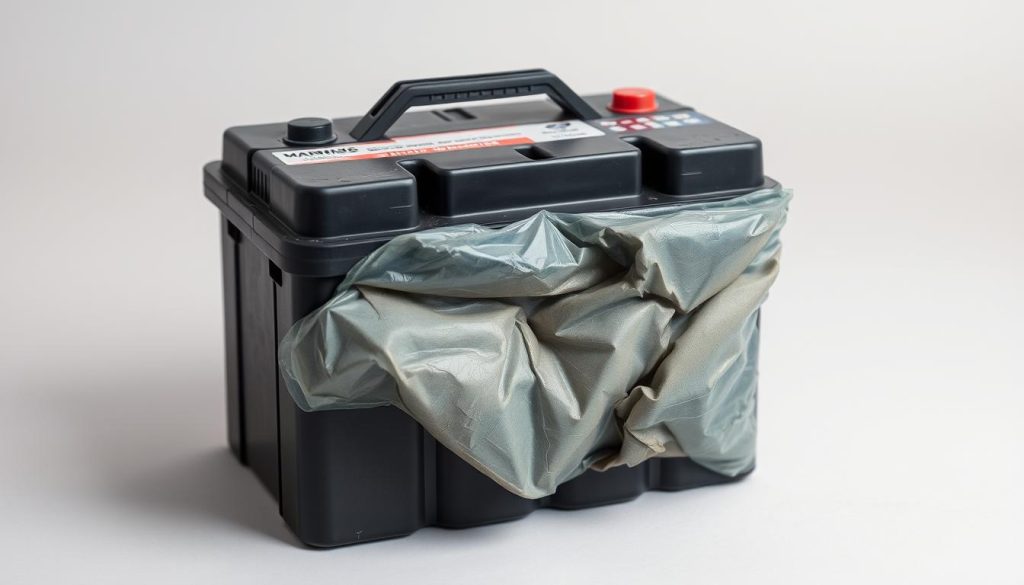
How to Test Your Car Battery
Knowing how to test your car battery is key to keeping your car running well. You can use a multimeter to check the voltage. This tells you if your battery is healthy.
A reading of 12.6 volts or higher means your battery is good. If you think your battery might be failing, a battery load test is a must. It checks how the battery does when it’s working hard.
Using a Multimeter
A multimeter costs about $10 and is very useful for checking your car battery. You connect it to the battery terminals to see the voltage. A healthy battery should show around 12.6 volts.
If the reading is below 12.0 volts, it might mean your battery needs more testing.
Battery Load Test
Checking voltage is just the start. A battery load test shows how well the battery works under stress. This is like checking how it does when you start the car.
Signs like a slow engine start or lights that flicker can mean you need to test your battery more.
Seeking Professional Help
If you’re not sure what your test results mean, getting help from a pro is a good idea. Experts at car service centers can give you clear answers and advice. They can tell you if your battery is okay or if you need a new one.
Knowing When to Replace Your Battery
It’s important to know when to replace your car battery. Most batteries last three to five years. Things like the weather and how you drive can affect this.
Watching for signs can help avoid big problems. This way, we can catch issues before they get worse.
Optimal Battery Lifespan
Batteries usually last three to five years. But, very hot or cold weather can make them wear out faster. This can cause the battery to swell.
It’s a good idea to check your battery often. This is more important in very hot or very cold places. Short trips and sitting for a long time can also hurt your battery.
Signs of Imminent Failure
Knowing when your battery might fail is key. Look out for these signs:
- Dimming headlights mean your battery might not be strong enough.
- A slow engine crank means your engine is hard to start.
- A clicking sound when you try to start the car means your battery is low.
- Problems with your car’s electrical system, like slow windows or a broken radio, mean your battery is not working right.
- The dashboard battery light coming on means there’s a problem with charging.
Ignoring these signs can cost a lot of money. Checking your battery often helps keep your car running well. It also keeps you from being stuck somewhere without a car.
Choosing the Right Replacement Battery
Choosing the right battery is key for a smooth ride. There are many types, each for different needs and budgets. Knowing these options helps us make good choices.
Different Battery Types Explained
There are three main types of replacement batteries:
- SLA (Sealed Lead Acid) batteries: These are easy to use and fit most cars.
- AGM (Absorbent Glass Mat) batteries: They last longer and handle more charge cycles.
- Gel-cell batteries: Good for deep discharges, but not always reliable in very cold or hot weather.
How to Determine the Right Size
Finding the right size is important. Here are common sizes:
- Size 24/24F fits many Honda, Acura, Toyota, Lexus, Nissan, and Infiniti cars.
- Size 35 is good for newer models from Toyota, Nissan, Honda, and Subaru.
- Size 48H6 works for many European and American cars.
Choosing the right size ensures it fits and works well.
Top Brands to Consider
It’s best to pick reliable brands for a replacement battery. Here are some top brands:
- Optima: Known for high performance and strong cold cranking amps (CCA).
- Interstate: Trusted for long life and good performance.
- DieHard: Offers strong batteries for different driving conditions.
- ACDelco: Found at service centers and GM dealerships.
- Bosch: Available at Pep Boys, with warranties like the 4-year replacement for Platinum Series S6 AGM.
By knowing about battery types, sizes, and top brands, we can pick the best battery for our needs.
DIY vs. Professional Battery Replacement
Choosing between DIY battery replacement and a professional mechanic is a big decision. Each choice has good and bad points that affect our decision.
Pros and Cons of DIY
DIY battery replacement is attractive for saving money. It can cut labor costs by about 50% compared to pros. The process is simple for those with some technical know-how. It usually takes 30 minutes to an hour to do it yourself.
But, DIY comes with risks. Around 30% of DIY jobs can cause safety issues like acid spills or electrical shocks. Also, about 25% of DIY jobs fail due to bad maintenance or wrong installation. It’s key to know these risks before trying it yourself.
When to Call a Mechanic
Knowing when to get a mechanic is important. About 70% of car owners choose pros for battery replacement. Mechanics give warranties on both the battery and work, lasting 1 to 3 years. If you’re not sure about your car’s battery needs, a mechanic is a good choice.
When facing corrosion or complex car electronics, a mechanic is a must. They ensure safe and right installation, avoiding DIY risks. For an easy solution, companies like Heaven Automotive offer expert battery replacement help.
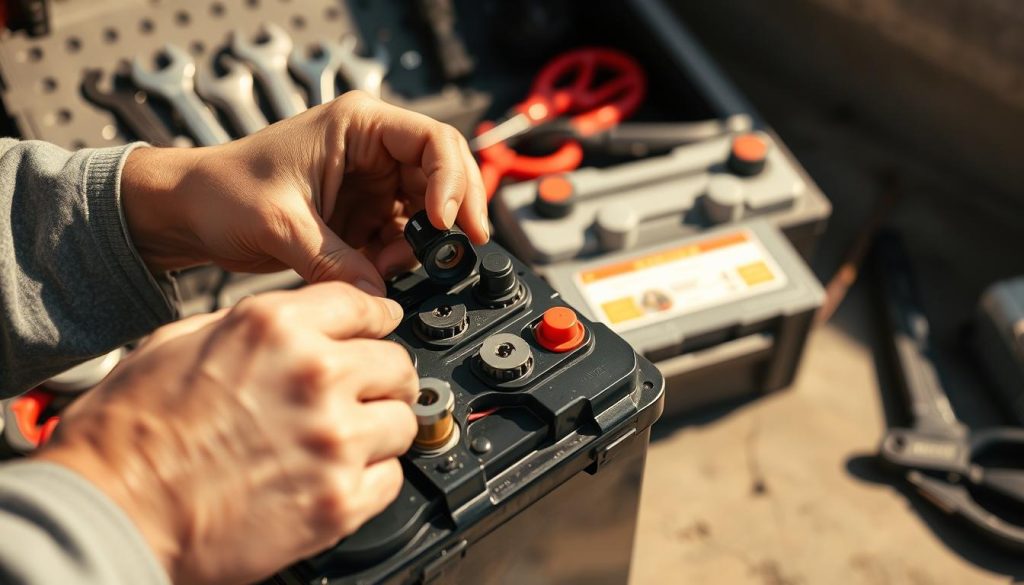
Proper Battery Maintenance Tips
We know keeping our battery in good shape is key. Doing regular inspections helps a lot. Simple steps can keep our car’s battery working well.
Regular Cleaning and Inspections
Cleaning and checking our battery often is important. Dirt on the terminals can slow down charging. Keeping them clean helps power flow better.
Looking for wear and tear helps catch problems early. This way, we avoid big issues later.
Keeping Terminals Tight
It’s important to keep battery terminals tight. If they’re loose, it can cause problems like slow starts. Checking and tightening them helps keep power flowing well.
Maintaining Optimal Charge Levels
We should watch the battery’s voltage often. A good battery should be at least 12.4 volts. Short trips don’t let the alternator fully charge it.
Try to drive longer to keep the battery healthy. This helps it work better, even in cold weather.
Recycling Your Old Car Battery
Recycling old car batteries is key to keeping our planet safe. It stops harmful stuff like lead and acid from getting into our air, water, and soil. We can recycle at many places, like stores and community groups.
Importance of Proper Disposal
Most car batteries in the U.S. get recycled, showing we care about the earth. But, not as many lithium-ion batteries are recycled. Recycling helps keep us and our planet healthy. It also gives us discounts on new batteries.
Finding Local Battery Recycling Options
There are many ways to find places to recycle batteries. Stores like Advance Auto Parts recycle and give you money back. Community programs also help get rid of dangerous waste. For example, High Tech Recycling in Pontiac, MI, takes batteries from you.
Cost of Car Battery Replacement
Replacing a car battery is a big deal for car care. Knowing how much it costs helps us plan. Costs change based on a few important things. We should know what affects these costs to make smart choices when it’s time to replace the battery.
Factors Influencing Replacement Costs
Many things affect how much it costs to replace a car battery. These include:
- Battery Type: Standard flooded batteries cost less than AGM batteries, which are $200 to $300.
- Vehicle Model: Some cars need special batteries or extra steps, which raises labor costs.
- Brand and Warranty: Famous brands with long warranties might cost more than unknown ones.
- Labor Costs: In the U.S., labor for battery replacement is about 1.1 hours, affecting the total cost.
Average Cost Range in the U.S.
In the U.S., battery replacement usually costs around $300. This includes the battery price and labor. A good battery costs between $130 and $140. Some stores sell batteries for as low as $44.99, but they might have short warranties. Knowing these average costs helps us budget and avoid surprises when a battery problem happens.
Conclusion: Staying Ahead of Battery Issues
To keep our cars running well, we need to take care of our batteries. We should watch for signs of a bad battery. This includes dim headlights, slow engine starts, or dashboard lights.
Knowing these signs helps us fix problems before they get worse. This way, we avoid breakdowns and don’t have to replace batteries suddenly.
Regular checks are key to a long-lasting battery. Problems like corrosion or low fluid can hurt battery life. Fixing these issues early can add up to 30% to our battery’s life.
Also, watching out for extreme temperatures is important. These can make our batteries work harder. Keeping our batteries in the best condition helps them perform well all year.
We should all check our batteries often and take care of them. If we see any warning signs, we should get help from experts. This way, we keep our cars safe and ensure a better driving experience for everyone.

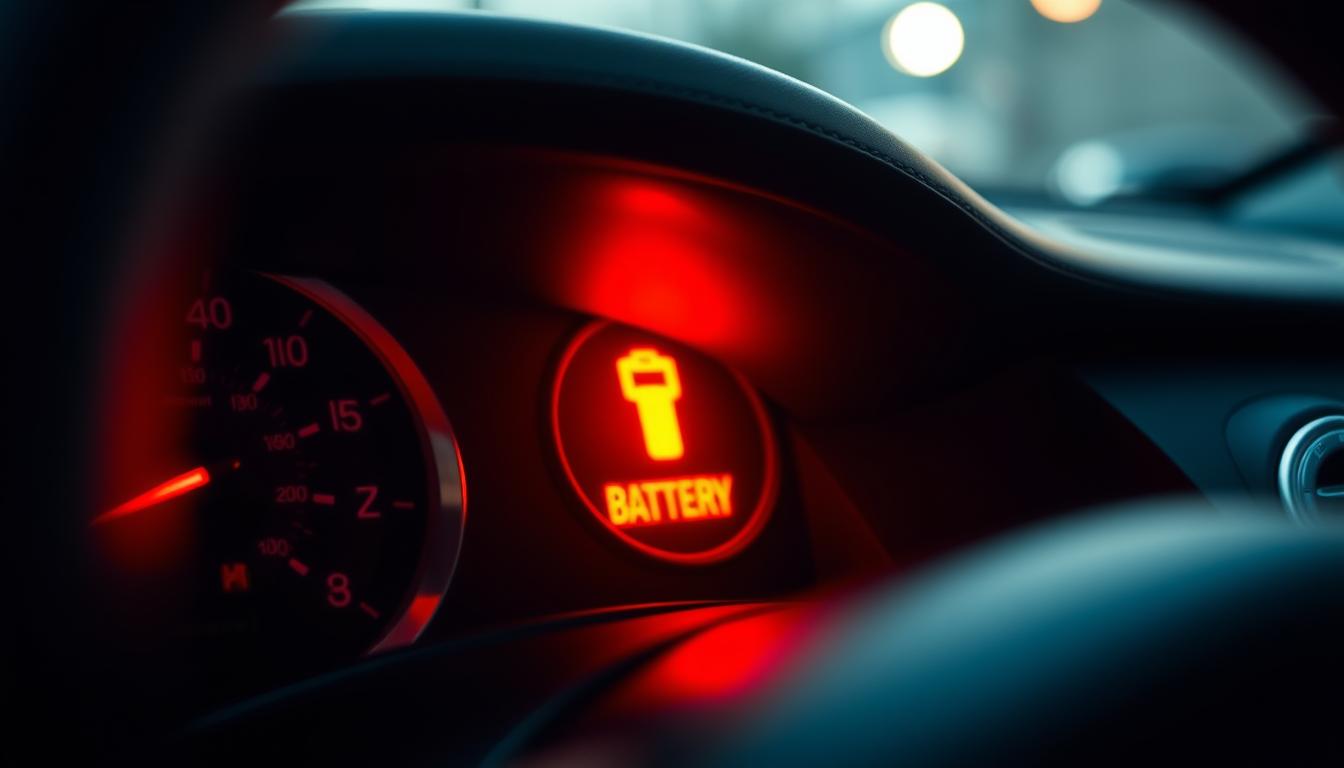
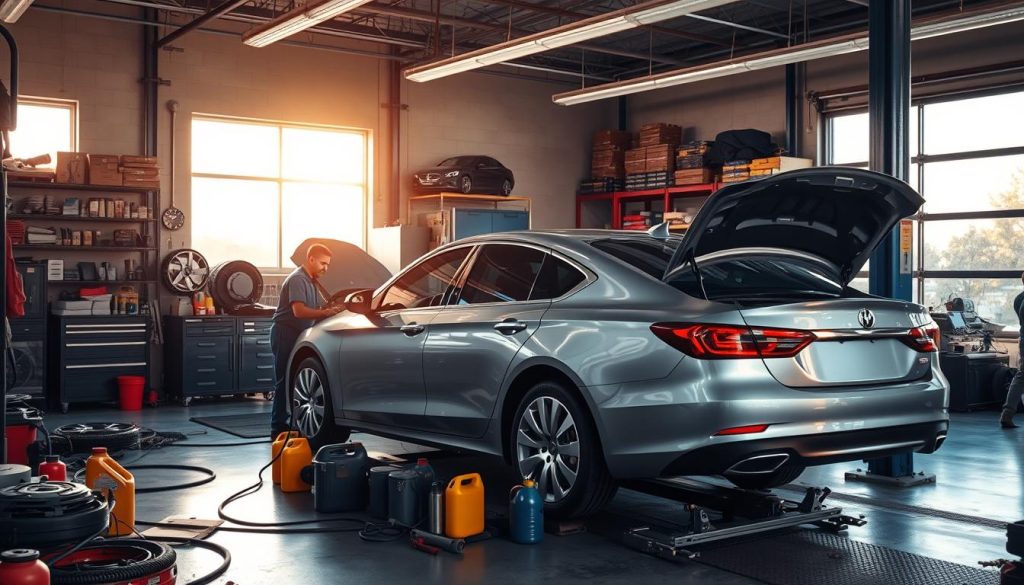
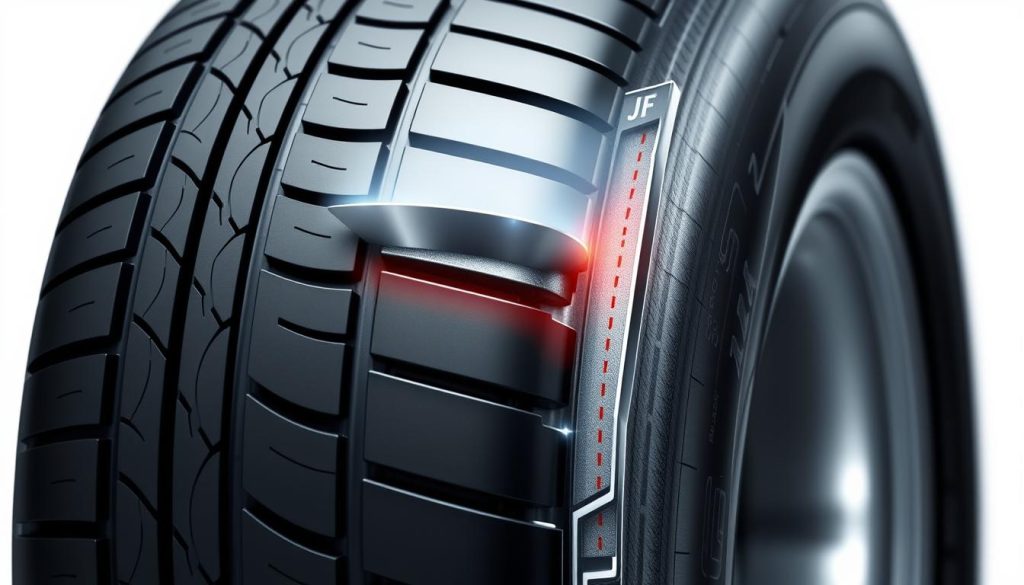
Comments are closed.